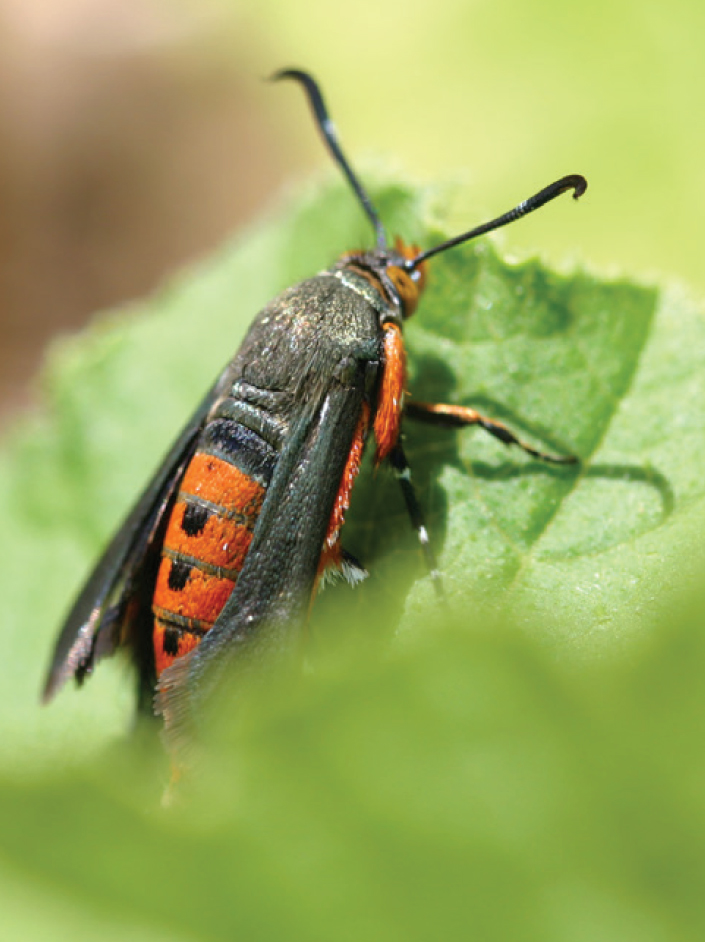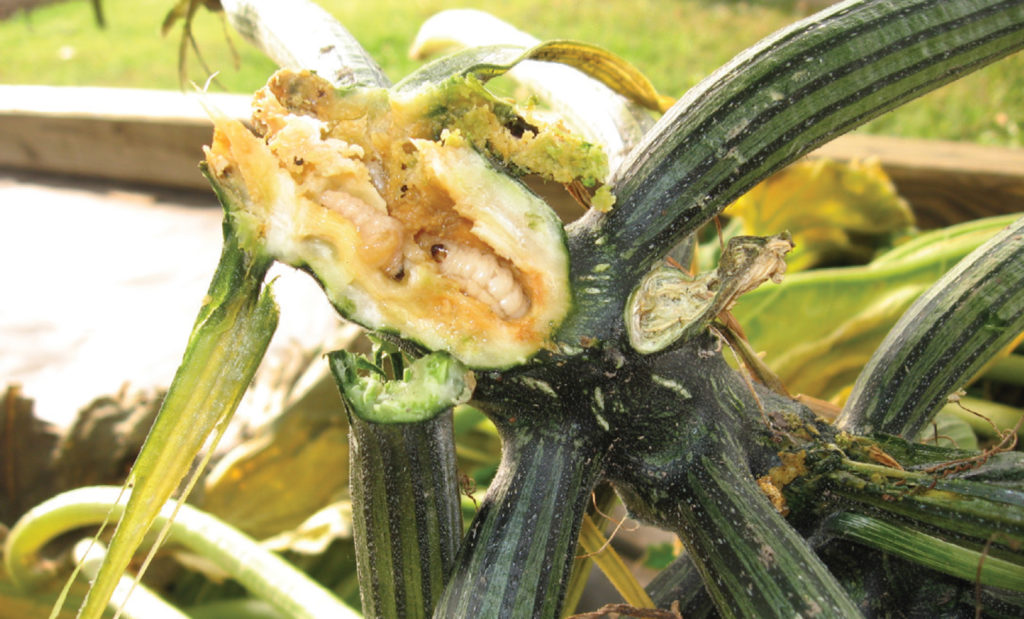A gardener recently asked me what she could do about squash vine borer. She then proceeded to list all the recommended treatments she had tried already, ranging from shooting the vines up (literally, with a hypodermic syringe full of Bt), to putting out yellow bowls to catch adult moths, to watching a gazillion videos on YouTube, to praying to the bird gods to eat the little buggers.
To answer her question I spent time reviewing a new and old publications, including a new review of the literature on this pest. Entomologists around the country also took the time to provide input on the question. As a result, I thought I would share some of the thoughts and ideas I gleaned with you.

The squash vine borer adult is fast moving and wasp-like in appearance. Photo courtesy Kansas State Unversity.
What is squash vine borer?
First of all, if you don’t know about squash vine borer and you live in Texas, you’re either very lucky or you’ve never tried to grow summer squash in your garden. Squash vine borer (SVB) can be one of the most frustrating pests on zucchini and other squashes. With zucchini at least you can have some fun squashing squash bugs and their eggs. Not so with vine borer, which burrows down into the vine as a tiny caterpillar. Once inside the plant, the larval stage burrows in the plant stem or crown, disrupts water and nutrient flow, and causes wilting and eventual death of the plant. All the while it remains mostly invisible to the peering gardener.
Adult squash vine borers are moths. They are attractive insects with bright red-orange scales covering the body and wings with a metallic green to black sheen. The hind wings are mostly clear. In flight, and in movement on the plant, they look much like a wasp.
One of the first important things to know about a garden pest is when it is active, and its number of generations annually. Squash vine borer adults are out as early as April/May in Texas and remain active until as late as November/December. There are thought to be at least two (overlapping) generations in Texas, meaning they can be active throughout the summer and fall.
The SVB has not been well-studied in Texas, but there are several good resources for information about its biology, life cycles and control. Check out the following if you want to dig deeper:
- Managing squash bugs in Organic Systems
- Kansas State fact sheet on squash vine borer [pdf]
- University of Tennessee fact sheet on Squash Vine Borer
- University of Florida’s Featured Creatures – Squash vine borer
- ATTRA: Squash bug and squash vine borer: Organic controls [pdf]
- Biology and management of squash vine borer: a scientific literature review [pdf]

Squash vine borer larvae live inside the stems of squash bushes and vines. Photo courtesy Kansas State university.
For the rest of us, here are some control suggestions. You will note that the title of this post is “Living with Squash Borer”. That’s because none of these techniques are magic, nor is there any perfect way to completely control this especially tenacious pest. But you can increase the life of your squash and improve your yield if you consider these suggestions. If you have a small garden, I suggest that you not rely on just chemical or on non-chemical methods alone, but integrate them together:
Non-chemical controls
- Till and rotate. Because SVB overwinters (up to two inches-deep) in the soil underneath its host plant, these two actions are very important. Promptly pull up spent and dying vines and discard or destroy. If you don’t, these vines will discharge SVB until all the larvae inside the plants have completed their development. After the garden is finished in the fall, either roto-till or turn over all the soil in the vicinity of the vines with a spade. By doing so you will expose many of the underground pupae to the elements and to hungry birds. If SVB have become a perennial problem in your garden, consider skipping a year of production to clear the soil of these pests.
- If you are starting with a garden that has been well tilled, or not used for squash the previous year, consider using a floating row cover over next year’s crop. Floating row covers are lightweight fabrics designed to withstand the elements while allowing sun and wind through. If well secured and buried around the edges, they can also keep SVB adults from laying eggs on your new squash vines. If you use these in a garden that had a previous infestation, however, keep in mind some of last year’s borers may actually emerge under the fabric. Also, you will need to hand pollinate your flowers, or remove the row cover once the plants start to bloom if you want bees to pollinate your female flowers.
- Consider planting some of the squash types that are less attractive to SVB. Examples include ‘Tatume’ (Calabacita) squash, white bush scallop, acorn squash, summer crookneck, Dickinson pumpkin, green-striped cushaw, butternut squash and zucchetta squash (suggested by Connecticut extension colleague Leanne Pundt, who especially likes Tatume for its hard stem and good flavor. Very vigorous grower, so give it room she says).
- Hand removing/killing larvae by slitting the stems with a knife can also prolong the life of infested vines. This is time consuming (though satisfying in a disturbing way), and only suitable for home gardens with relatively few plants. Look for stems with oozing plant residue (frass) and slit open with a knife. There may be multiple larvae in a single stem. Carefully pry them out and use them to feed the birds or as fish bait (it’s only fair).
- Some people suggest staggering your squash planting dates, so that you have different aged plants through the summer. As you pull older vines succumbing to the borer, younger, still healthy, plants will take their places and continue producing.
Chemical controls
- The gardener’s favorite bacterial insecticide, Bacillus thuringiensis, can be sprayed or injected into squash stems. Keep in mind that Bt degrades quickly in sunlight, so it will not provide much residual control and will need to be reapplied frequently. This is true of any insecticide on fast-growing plants like squash. Injecting Bt into the hollow stems of squash is another way to treat; however it is more time-consuming and not necessarily more effective.
- Spinosad is another organically derived insecticide with low toxicity similar to Bt; however spinosad tends to last longer on plant surfaces. Spray your plant stems weekly with spinosad for control of SVB, but do it in the evening when bee activity has ceased. Spinosad is toxic to bees when wet.
- Entomopathogenic nematodes are microscopic roundworms that specialize on killing insects. Nematodes have provided variable control of SVB in university tests (sometimes good, sometimes not), but in some studies they have been as effective as conventional synthetic insecticides. You can purchase these creatures online or over the phone. For a list of suppliers, see http://anbp.org/index.php/members-products
- Use of conventional insecticide sprays can also be an effective technique for controlling SVB. Because the eggs of the moth are laid solely on stems and vines, in the home garden insecticides can be applied directly to these sites, largely avoiding leaves, flowers and fruits. Several insecticides are labeled for such use, including acetamiprid (lower toxicity to bees), carbaryl, permethrin, bifenthrin, esfenvalerate and others. Sprays should be applied at the first sign of moths or larval entry and repeated weekly. Some growers may prefer to apply conventional insecticides up until the time of full bloom and then stop spraying, or switch to nematodes, natural Bt, or spinosad sprays. Be sure to check labels to ensure they are for use on garden vegetables, and how long you must wait after spraying before harvest.
Surprisingly, for reasons not fully understood, small home gardens seem to have worse problems with SVB than large farms. Despite the challenges posed by this frustrating pest, you can still grow summer squash in Texas with a little persistence and patience. And maybe next year you’ll even have enough to share with the neighbors.